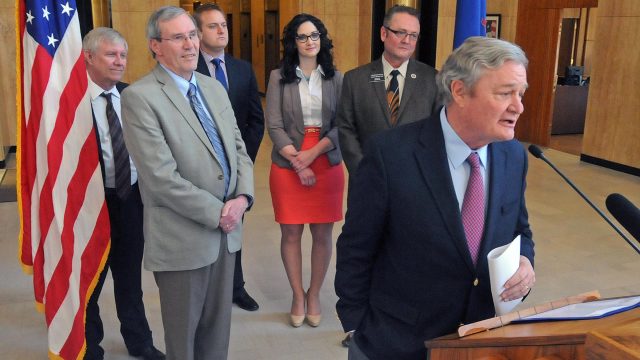Looming Budget Fight Illustrates How Dumb North Dakota's Approach To Property Tax Relief Has Been

TOM STROMME.Tribune Governor Jack Dalrymple, right, along with members of the Governor's Task Force For Property Tax Reform and the legislature announced a final tax cut relief package totaling $400 million in income and property taxes for the people of North Dakota on Tuesday morning in the state capitol in Bismarck. In back from left are Rep. Mark Owens (R-Grand Forks), Sen. Dwight Cook (R-Mandan), Tax Commissioner Ryan Rauschenberger, Sen. Jessica Unruh (R-Beulah) and Rep. Craig Headland (R-Montpelier).
Yesterday North Dakota’s Democrats, as they are wont to do in election years, demanded a special session of the legislature to address spending reductions. They apparently think even the modest 4.04 percent spending allotments announced in February by Governor Jack Dalrymple go too far.
But what caught my eye was this tweet from state Senator Erin Oban, a Democrat from Bismarck, who suggested that the spending cuts might put property tax relief in jeopardy:
@NDDemNPLCaucus call 4 special session 2 protect kids,elderly,ppl w/ disabilities,ppty relief frm cuts #ndpol #ndleg pic.twitter.com/O6OokvjlsO
— Erin Oban (@ErinOban) March 29, 2016
What’s interesting about that argument is it lays bare how dumb North Dakota’s approach to approach to property tax relief has been.
Since when is tax relief a spending line item?
The truth is that the “property tax relief” the Legislature has been passing – mostly at the behest of Republican governors John Hoeven and Jack Dalrymple – is little more than a shell game. It was the state shifting local spending into the state budget with the idea that the local governments would then reduce their taxes.
Only the local governments haven’t always done a very good job of passing the savings from smaller local budgets on to the property tax base. And then there’s the reality of all that bought up spending sitting in the state budget.
Back when North Dakota was in the mist of an oil boom, with a tsunami of revenue flowing into state coffers, it was easy to call that shift of local spending into the state budget “tax relief.” Because we had so much revenue surplus at the state level, nobody noticed the burden of local spending obligations.
But the era of oil boom revenue surpluses is over, but the spending obligations for property “tax relief” remain. And the obligations are not small. This graph, prepared by Legislative Council, shows major state aid to political subdivisions (counties, cities, etc.). As you can see, thanks in no small part to growing “tax relief” spending obligations, the growth has been significant:

The state-paid property tax relief credits are one factor, of course, as is the growth in school-related funding which has been the primary focus of the Legislature’s property tax buy downs. And the school-related portion is going to keep going up, because if there is one certainty in life in addition to death and taxes it’s that school funding goes up.
Some, including this humble observer, have been arguing for years that the Legislature is creating future headaches for itself with this property tax shell game. With revenues falling, and the budget coming up short, the time for those headaches has arrived.




